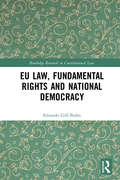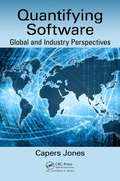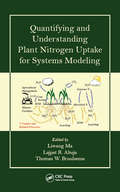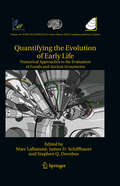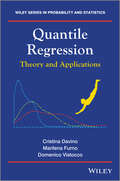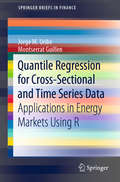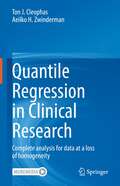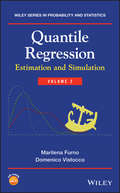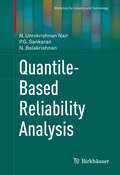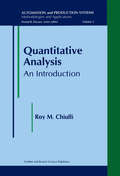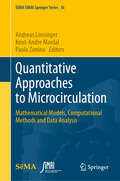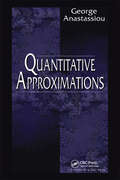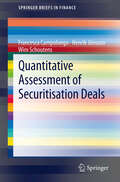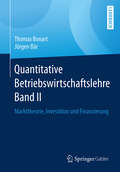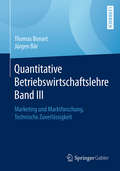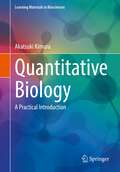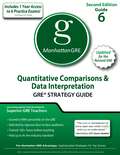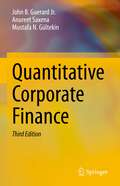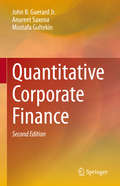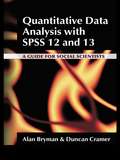- Table View
- List View
Quantifying Software: Global and Industry Perspectives (Routledge Research In Constitutional Law Ser.)
by Capers JonesSoftware is one of the most important products in human history and is widely used by all industries and all countries. It is also one of the most expensive and labor-intensive products in human history. Software also has very poor quality that has caused many major disasters and wasted many millions of dollars. Software is also the target of frequent and increasingly serious cyber-attacks. <P><P>Among the reasons for these software problems is a chronic lack of reliable quantified data. This reference provides quantified data from many countries and many industries based on about 26,000 projects developed using a variety of methodologies and team experience levels. The data has been gathered between 1970 and 2017, so interesting historical trends are available. <P><P>Since current average software productivity and quality results are suboptimal, this book focuses on "best in class" results and shows not only quantified quality and productivity data from best-in-class organizations, but also the technology stacks used to achieve best-in-class results. The overall goal of this book is to encourage the adoption of best-in-class software metrics and best-in-class technology stacks. It does so by providing current data on average software schedules, effort, costs, and quality for several industries and countries. <P><P>Because productivity and quality vary by technology and size, the book presents quantitative results for applications between 100 function points and 100,000 function points. It shows quality results using defect potential and DRE metrics because the number one cost driver for software is finding and fixing bugs. The book presents data on cost of quality for software projects and discusses technical debt, but that metric is not standardized. Finally, the book includes some data on three years of software maintenance and enhancements as well as some data on total cost of ownership.
Quantifying Software: Global and Industry Perspectives (Routledge Research In Constitutional Law Ser.)
by Capers JonesSoftware is one of the most important products in human history and is widely used by all industries and all countries. It is also one of the most expensive and labor-intensive products in human history. Software also has very poor quality that has caused many major disasters and wasted many millions of dollars. Software is also the target of frequent and increasingly serious cyber-attacks. Among the reasons for these software problems is a chronic lack of reliable quantified data. This reference provides quantified data from many countries and many industries based on about 26,000 projects developed using a variety of methodologies and team experience levels. The data has been gathered between 1970 and 2017, so interesting historical trends are available. Since current average software productivity and quality results are suboptimal, this book focuses on "best in class" results and shows not only quantified quality and productivity data from best-in-class organizations, but also the technology stacks used to achieve best-in-class results. The overall goal of this book is to encourage the adoption of best-in-class software metrics and best-in-class technology stacks. It does so by providing current data on average software schedules, effort, costs, and quality for several industries and countries. Because productivity and quality vary by technology and size, the book presents quantitative results for applications between 100 function points and 100,000 function points. It shows quality results using defect potential and DRE metrics because the number one cost driver for software is finding and fixing bugs. The book presents data on cost of quality for software projects and discusses technical debt, but that metric is not standardized. Finally, the book includes some data on three years of software maintenance and enhancements as well as some data on total cost of ownership.
Quantifying and Understanding Plant Nitrogen Uptake for Systems Modeling
by Liwang Ma Lajpat R. Ahuja Tom BruulsemaDiscusses New Advancements to Improve Existing Simulations of Plant NitrogenWritten by research pioneers and leading scientists in the area of agricultural systems, Quantifying and Understanding Plant Nitrogen Uptake for Systems Modeling comprehensively covers plant N uptake in agricultural system models, especially for building soil-plant system m
Quantifying the Evolution of Early Life
by James D. Schiffbauer Marc Laflamme Stephen Q. DornbosThis volume provides a detailed description of a wide range of numerical, statistical or modeling techniques and novel instrumentation separated into individual chapters written by paleontologists with expertise in the given methodology. Each chapter outlines the strengths and limitations of specific numerical or technological approaches, and ultimately applies the chosen method to a real fossil dataset or sample type. A unifying theme throughout the book is the evaluation of fossils during the prologue and epilogue of one of the most exciting events in Earth History: the Cambrian radiation.
Quantile Regression
by Marilena Furno Cristina Davino Domenico VistoccoA guide to the implementation and interpretation of Quantile Regression modelsThis book explores the theory and numerous applications of quantile regression, offering empirical data analysis as well as the software tools to implement the methods.The main focus of this book is to provide the reader with a comprehensive description of the main issues concerning quantile regression; these include basic modeling, geometrical interpretation, estimation and inference for quantile regression, as well as issues on validity of the model, diagnostic tools. Each methodological aspect is explored and followed by applications using real data.Quantile Regression:Presents a complete treatment of quantile regression methods, including, estimation, inference issues and application of methods.Delivers a balance between methodolgy and applicationOffers an overview of the recent developments in the quantile regression framework and why to use quantile regression in a variety of areas such as economics, finance and computing.Features a supporting website (www.wiley.com/go/quantile_regression) hosting datasets along with R, Stata and SAS software code.Researchers and PhD students in the field of statistics, economics, econometrics, social and environmental science and chemistry will benefit from this book.
Quantile Regression
by Roger KoenkerQuantile regression is gradually emerging as a unified statistical methodology for estimating models of conditional quantile functions. By complementing the exclusive focus of classical least squares regression on the conditional mean, quantile regression offers a systematic strategy for examining how covariates influence the location, scale and shape of the entire response distribution. This monograph is the first comprehensive treatment of the subject, encompassing models that are linear and nonlinear, parametric and nonparametric. The author has devoted more than 25 years of research to this topic. The methods in the analysis are illustrated with a variety of applications from economics, biology, ecology and finance. The treatment will find its core audiences in econometrics, statistics, and applied mathematics in addition to the disciplines cited above.
Quantile Regression for Cross-Sectional and Time Series Data: Applications in Energy Markets Using R (SpringerBriefs in Finance)
by Jorge M. Uribe Montserrat GuillenThis brief addresses the estimation of quantile regression models from a practical perspective, which will support researchers who need to use conditional quantile regression to measure economic relationships among a set of variables. It will also benefit students using the methodology for the first time, and practitioners at private or public organizations who are interested in modeling different fragments of the conditional distribution of a given variable. The book pursues a practical approach with reference to energy markets, helping readers learn the main features of the technique more quickly. Emphasis is placed on the implementation details and the correct interpretation of the quantile regression coefficients rather than on the technicalities of the method, unlike the approach used in the majority of the literature. All applications are illustrated with R.
Quantile Regression in Clinical Research: Complete analysis for data at a loss of homogeneity
by Aeilko H. Zwinderman Ton J. CleophasQuantile regression is an approach to data at a loss of homogeneity, for example (1) data with outliers, (2) skewed data like corona - deaths data, (3) data with inconstant variability, (4) big data. In clinical research many examples can be given like circadian phenomena, and diseases where spreading may be dependent on subsets with frailty, low weight, low hygiene, and many forms of lack of healthiness. Stratified analyses is the laborious and rather explorative way of analysis, but quantile analysis is a more fruitful, faster and completer alternative for the purpose. Considering all of this, we are on the verge of a revolution in data analysis. The current edition is the first textbook and tutorial of quantile regressions for medical and healthcare students as well as recollection/update bench, and help desk for professionals. Each chapter can be studied as a standalone and covers one of the many fields in the fast growing world of quantile regressions. Step by step analyses of over 20 data files stored at extras.springer.com are included for self-assessment. We should add that the authors are well qualified in their field. Professor Zwinderman is past-president of the International Society of Biostatistics (2012-2015) and Professor Cleophas is past-president of the American College of Angiology(2000-2002). From their expertise they should be able to make adequate selections of modern quantile regression methods for the benefit of physicians, students, and investigators.
Quantile Regression: Applications on Experimental and Cross Section Data using EViews
by I. Gusti AgungQUANTILE REGRESSION A thorough presentation of Quantile Regression designed to help readers obtain richer information from data analysesThe conditional least-square or mean-regression (MR) analysis is the quantitative research method used to model and analyze the relationships between a dependent variable and one or more independent variables, where each equation estimation of a regression can give only a single regression function or fitted values variable. As an advanced mean regression analysis, each estimation equation of the mean-regression can be used directly to estimate the conditional quantile regression (QR), which can quickly present the statistical results of a set nine QR(τ)s for τ(tau)s from 0.1 up to 0.9 to predict detail distribution of the response or criterion variable. QR is an important analytical tool in many disciplines such as statistics, econometrics, ecology, healthcare, and engineering.Quantile Regression: Applications on Experimental and Cross Section Data Using EViews provides examples of statistical results of various QR analyses based on experimental and cross section data of a variety of regression models. The author covers the applications of one-way, two-way, and n-way ANOVA quantile regressions, QRs with multi numerical predictors, heterogeneous QRs, and latent variables QRs, amongst others. Throughout the text, readers learn how to develop the best possible quantile regressions and how to conduct more advanced analysis using methods such as the quantile process, the Wald test, the redundant variables test, residual analysis, the stability test, and the omitted variables test. This rigorous volume:Describes how QR can provide a more detailed picture of the relationships between independent variables and the quantiles of the criterion variable, by using the least-square regressionPresents the applications of the test for any quantile of any numerical response or criterion variableExplores relationship of QR with heterogeneity: how an independent variable affects a dependent variableOffers expert guidance on forecasting and how to draw the best conclusions from the results obtainedProvides a step-by-step estimation method and guide to enable readers to conduct QR analysis using their own data setsIncludes a detailed comparison of conditional QR and conditional mean regressionQuantile Regression: Applications on Experimental and Cross Section Data Using EViews is a highly useful resource for students and lecturers in statistics, data analysis, econometrics, engineering, ecology, and healthcare, particularly those specializing in regression and quantitative data analysis.
Quantile Regression: Estimation and Simulation (Wiley Series in Probability and Statistics #988)
by Marilena Furno Domenico VistoccoContains an overview of several technical topics of Quantile Regression Volume two of Quantile Regression offers an important guide for applied researchers that draws on the same example-based approach adopted for the first volume. The text explores topics including robustness, expectiles, m-quantile, decomposition, time series, elemental sets and linear programming. Graphical representations are widely used to visually introduce several issues, and to illustrate each method. All the topics are treated theoretically and using real data examples. Designed as a practical resource, the book is thorough without getting too technical about the statistical background. The authors cover a wide range of QR models useful in several fields. The software commands in R and Stata are available in the appendixes and featured on the accompanying website. The text: Provides an overview of several technical topics such as robustness of quantile regressions, bootstrap and elemental sets, treatment effect estimators Compares quantile regression with alternative estimators like expectiles, M-estimators and M-quantiles Offers a general introduction to linear programming focusing on the simplex method as solving method for the quantile regression problem Considers time-series issues like non-stationarity, spurious regressions, cointegration, conditional heteroskedasticity via quantile regression Offers an analysis that is both theoretically and practical Presents real data examples and graphical representations to explain the technical issues Written for researchers and students in the fields of statistics, economics, econometrics, social and environmental science, this text offers guide to the theory and application of quantile regression models.
Quantile-Based Reliability Analysis
by N. Balakrishnan P. G. Sankaran N. Unnikrishnan NairThis book provides a fresh approach to reliability theory, an area that has gained increasing relevance in fields from statistics and engineering to demography and insurance. Its innovative use of quantile functions gives an analysis of lifetime data that is generally simpler, more robust, and more accurate than the traditional methods, and opens the door for further research in a wide variety of fields involving statistical analysis. In addition, the book can be used to good effect in the classroom as a text for advanced undergraduate and graduate courses in Reliability and Statistics.
Quantitative Analysis and IBM® SPSS® Statistics
by Abdulkader AljandaliThis guide for practicing statisticians and data scientists who use IBM SPSS for statistical analysis of big data in business and finance is the first of a two-part guide to SPSS for Windows, introducing data entry into SPSS, along with elementary statistical and graphical methods for summarizing and presenting data. Part I also covers the rudiments of hypothesis testing and business forecasting while Part II will present multivariate statistical methods, more advanced forecasting methods, and multivariate methods. IBM SPSS offers a powerful set of statistical and information analysis systems that run on a wide variety of personal computers. The Windows version of SPSS is built around routines that have been developed, tested, and widely used for more than 20 years. As such, SPSS is extensively used in industry, commerce, banking, local and national governments, and education. Just a small subset of users of the package include the major clearing banks, the BBC, British Gas, British Airways, British Telecom, the Consumer Association, Eurotunnel, Glaxo, ICI, London Underground, the NHS, Plessey, Shell, Unilever, and W. H. Smith and Son. Although the emphasis in this guide is on applications of SPSS for Windows, there is a need for users to be aware of the statistical assumptions and rationales underpinning correct and meaningful application of the techniques available in the packa≥ therefore, such assumptions are discussed, and methods of assessing their validity are described. Also presented is the logic underlying the computation of the more commonly used test statistics in the area of hypothesis testing. Mathematical background is kept to a minimum.
Quantitative Analysis and IBM® SPSS® Statistics: A Guide for Business and Finance (Statistics and Econometrics for Finance)
by Abdulkader AljandaliThis guide is for practicing statisticians and data scientists who use IBM SPSS for statistical analysis of big data in business and finance. This is the first of a two-part guide to SPSS for Windows, introducing data entry into SPSS, along with elementary statistical and graphical methods for summarizing and presenting data. Part I also covers the rudiments of hypothesis testing and business forecasting while Part II will present multivariate statistical methods, more advanced forecasting methods, and multivariate methods. IBM SPSS Statistics offers a powerful set of statistical and information analysis systems that run on a wide variety of personal computers. The software is built around routines that have been developed, tested, and widely used for more than 20 years. As such, IBM SPSS Statistics is extensively used in industry, commerce, banking, local and national governments, and education. Just a small subset of users of the package include the major clearing banks, the BBC, British Gas, British Airways, British Telecom, the Consumer Association, Eurotunnel, GSK, TfL, the NHS, Shell, Unilever, and W.H.S. Although the emphasis in this guide is on applications of IBM SPSS Statistics, there is a need for users to be aware of the statistical assumptions and rationales underpinning correct and meaningful application of the techniques available in the package; therefore, such assumptions are discussed, and methods of assessing their validity are described. Also presented is the logic underlying the computation of the more commonly used test statistics in the area of hypothesis testing. Mathematical background is kept to a minimum.
Quantitative Analysis and Optimal Control of Energy Efficiency in Discrete Manufacturing System
by Yan Wang Cheng-Lin Liu Zhi-Cheng JiThis book provides energy efficiency quantitative analysis and optimal methods for discrete manufacturing systems from the perspective of global optimization. In order to analyze and optimize energy efficiency for discrete manufacturing systems, it uses real-time access to energy consumption information and models of the energy consumption, and constructs an energy efficiency quantitative index system. Based on the rough set and analytic hierarchy process, it also proposes a principal component quantitative analysis and a combined energy efficiency quantitative analysis. In turn, the book addresses the design and development of quantitative analysis systems. To save energy consumption on the basis of energy efficiency analysis, it presents several optimal control strategies, including one for single-machine equipment, an integrated approach based on RWA-MOPSO, and one for production energy efficiency based on a teaching and learning optimal algorithm. Given its scope, the book offers a valuable guide for students, teachers, engineers and researchers in the field of discrete manufacturing systems.
Quantitative Analysis: An Introduction
by RoyM ChiulliWritten in a lecture format with solved problems at the end of each chapter, this book surveys quantitative modeling and decision analysis techniques. It serves to familiarize the reader with quantitative techniques utilized in planning and optimizing complex systems, as well as students experiencing the subject for the first time. It can be used by students of business and public administration without a background in calculus as well as engineers with significant scientific training. It allows the reader to comprehend the material through examples and problems and also demonstrates the value and shortcomings of many methods. Quantitative Analysis: An introduction developed out of the author's experience teaching the material to students at the University of California Los Angeles, California State University, Northridge, and the University of Southern California, Los Angeles.
Quantitative Approaches to Microcirculation: Mathematical Models, Computational Methods and Data Analysis (SEMA SIMAI Springer Series #36)
by Paolo Zunino Kent-Andre Mardal Andreas LinningerMicrocirculation is a key area of interest within the realms of biology and medicine. As a vital discipline, microcirculatory biology forms a significant part of established medical fields like cardiovascular medicine and oncology, and is increasingly relevant in emerging fields such as neuroscience. With its multifaceted nature, the study of microcirculation has evolved from basic observations and experiments to embrace cutting-edge imaging technologies, quantitative methods, and the power of data science. This volume brings together a series of insightful chapters that highlight the latest trends in modeling microcirculation. It casts a spotlight on the vital role of microcirculation in brain function modeling and the innovative applications of microvascular models in oncology. Readers will be introduced to state-of-the-art methodologies of microcirculation modeling. A key focus is on mixed-dimensional models, mathematical methods adept at describing complex interactions within lower dimensional manifolds. Each chapter thoughtfully navigates the mathematical, computational, and practical challenges of these approaches, underscoring their effectiveness in capturing the essence of microcirculation. This book offers a window into the latest advancements and methodologies that are shaping the future of this vital field.
Quantitative Approximations
by George AnastassiouQuantitative approximation methods apply in many diverse fields of research-neural networks, wavelets, partial differential equations, probability and statistics, functional analysis, and classical analysis to name just a few. For the first time in book form, Quantitative Approximations provides a thorough account of all of the significant developm
Quantitative Assessment of Securitisation Deals
by Wim Schoutens Henrik Jönsson Francesca CampolongoThe book draws on current research on model risk and parameter sensitivity of securitisation ratings. It provides practical ideas and tools that can facilitate a more informed usage of securitisation ratings. We show how global sensitivity analysis techniques can be used to better analyse and to enhance the understanding of the uncertainties inherent in ratings due to uncertainty in the input parameters. The text introduces a novel global rating approach that takes the uncertainty in the ratings into account when assigning ratings to securitisation products. The book also covers new prepayment and default models that overcome flaws in current models.
Quantitative Betriebswirtschaftslehre Band II: Markttheorie, Investition und Finanzierung
by Thomas Bonart Jürgen BärDas dreibändige Lehrbuch „Quantitative BWL“ stellt die theoretischen quantitativen Grundlagen der betrieblichen Entscheidungen und des marktwirtschaftlichen Umfelds dar. Es ist für Studierende der Wirtschaftswissenschaften und des Wirtschaftsingenieurwesens im Bachelor- und Masterprogramm konzipiert. Auch komplexe Inhalte werden durch zahlreiche Beispiele verständlich und anschaulich erklärt. Zu jedem Kapitel gibt es Übungsaufgaben mit Lösungshinweisen. Somit eignet sich das Lehrbuch zur Unterstützung von Vorlesungen, aber auch zum autodidaktischen Lernen.
Quantitative Betriebswirtschaftslehre Band III: Marketing und Marktforschung, Technische Zuverlässigkeit
by Thomas Bonart Jürgen BärDas dreibändige Lehrbuch „Quantitative BWL“ stellt die theoretischen quantitativen Grundlagen der betrieblichen Entscheidungen und des marktwirtschaftlichen Umfelds dar. Es ist für Studierende der Wirtschaftswissenschaften und des Wirtschaftsingenieurwesens im Bachelor- und Masterprogramm konzipiert. Auch komplexe Inhalte werden durch zahlreiche Beispiele verständlich und anschaulich erklärt. Zu jedem Kapitel gibt es Übungsaufgaben mit Lösungshinweisen. Somit eignet sich das Lehrbuch zur Unterstützung von Vorlesungen, aber auch zum autodidaktischen Lernen.
Quantitative Biology: A Practical Introduction (Learning Materials in Biosciences)
by Akatsuki KimuraThis textbook is for biologists, to conduct quantitative analysis and modeling of biological processes at molecular and cellular levels. Focusing on practical concepts and techniques for everyday research, this text will enable beginners, both students and established biologists, to take the first step in quantitative biology. It also provides step-by-step tutorials to run various sample programs in one’s personal computer using Excel and Python. This volume traces topics, starting with an introductory chapter, such as modeling, construction and execution of numerical models, and key concepts in quantitative biology: feedback regulations, fluctuations and randomness, and statistical analyses. It also provide sample codes with guidance to procedure programming for actual biological processes such as movement of the nucleus within a cell, cell-cycle regulation, stripe pattern formation of skins, and distribution of energy. Written by a leading research scientist who has a background in biology, studied quantitative approaches by himself, and teaches quantitative biology at several universities, this textbook broadens quantitative approaches for biologists who do not have a strong background in mathematics, physics, or computer programming, and helps them progress further in their research.
Quantitative Comparisons & Data Interpretations Math GRE Strategy Guide
by Manhattan Gre StaffUpdated for the revised GRE, this guide is really two books in one, thoroughly covering two of the quantitative question types on the GRE. The Guide to Quantitative Comparisons provides students a framework for understanding what Quantitative Comparisons questions tests. Most importantly, it discusses time-saving strategies specific to the Quantitative Comparisons format. The Guide to Data Interpretation presents an overview of the types of graphs students can expect to see on the GRE. It also discusses the different types of questions typically seen on the GRE and provides guidelines for reading graphs and combining information from different graphs to answer questions. Purchase of this book includes one year of access to 6 of Manhattan GRE's online practice exams.
Quantitative Corporate Finance
by John B. Guerard Jr. Anureet Saxena Mustafa N. GültekinThis textbook presents a comprehensive treatment of the legal arrangement of the corporation, the instruments and institutions through which capital can be raised, the management of the flow of funds through the individual firm, and the methods of dividing the risks and returns among the various contributors of funds.Now in its third edition, the book covers a wide range of topics in corporate finance, from time series modeling and regression analysis to multi-factor risk models and the Capital Asset Pricing Model. Guerard, Gultekin and Saxena build significantly on the first edition of the text, but retain the core chapters on cornerstone topics such as mergers and acquisitions, regulatory environments, bankruptcy and various other foundational concepts of corporate finance.New to the third edition are examinations of APT portfolio selection and time series modeling and forecasting through SAS, SCA and OxMetrics programming, FactSet fundamental data templates. This is intended to be a graduate-level textbook, and could be used as a primary text in upper level MBA and Financial Engineering courses, as well as a supplementary text for graduate courses in financial data analysis and financial investments.
Quantitative Corporate Finance
by John B. Guerard Jr. Anureet Saxena Mustafa GultekinThis textbook presents a comprehensive treatment of the legal arrangement of the corporation, the instruments and institutions through which capital can be raised, the management of the flow of funds through the individual firm, and the methods of dividing the risks and returns among the various contributors of funds.Now in its second edition, the book covers a wide range of topics in corporate finance, from time series modeling and regression analysis to multi-factor risk models and the Capital Asset Pricing Model. Guerard, Gultekin and Saxena build significantly on the first edition of the text, but retain the core chapters on cornerstone topics such as mergers and acquisitions, regulatory environments, bankruptcy and various other foundational concepts of corporate finance.New to the second edition are examinations of APT portfolio selection and time series modeling and forecasting through SAS, SCA and OxMetrics programming, FactSet fundamental data templates. This is intended to be a graduate-level textbook, and could be used as a primary text in upper level MBA and Financial Engineering courses, as well as a supplementary text for graduate courses in financial data analysis and financial investments.
Quantitative Data Analysis with SPSS 12 and 13: A Guide for Social Scientists
by Alan Bryman Duncan CramerThis new edition has been completely updated to accommodate the needs of users of SPSS Release 12 and 13 for Windows, whilst still being applicable to those using SPSS Release 11 and 10. Alan Bryman and Duncan Cramer provide a non-technical approach to quantitative data analysis and a user-friendly introduction to the widely used SPSS. No previous familiarity with computing or statistics is required to benefit from this step-by-step guide to techniques including: Non-parametric tests Correlation Simple and multiple regression Multivarate analysis of variance and covariance Factor analysis The authors discuss key issues facing the newcomer to research, such as how to decide which statistical procedure is suitable, and how to interpret the subsequent results. Each chapter contains worked examples to illustrate the points raised and ends with a comprehensive range of exercises which allow the reader to test their understanding of the topic. This new edition of this hugely successful textbook will guide the reader through the basics of quantitative data analysis and become an essential reference tool for both students and researchers in the social sciences. The datasets used in Quantitative Data Analysis for SPSS Release 12 and 13 are available online at www.psypress.com/brymancramer/ .
